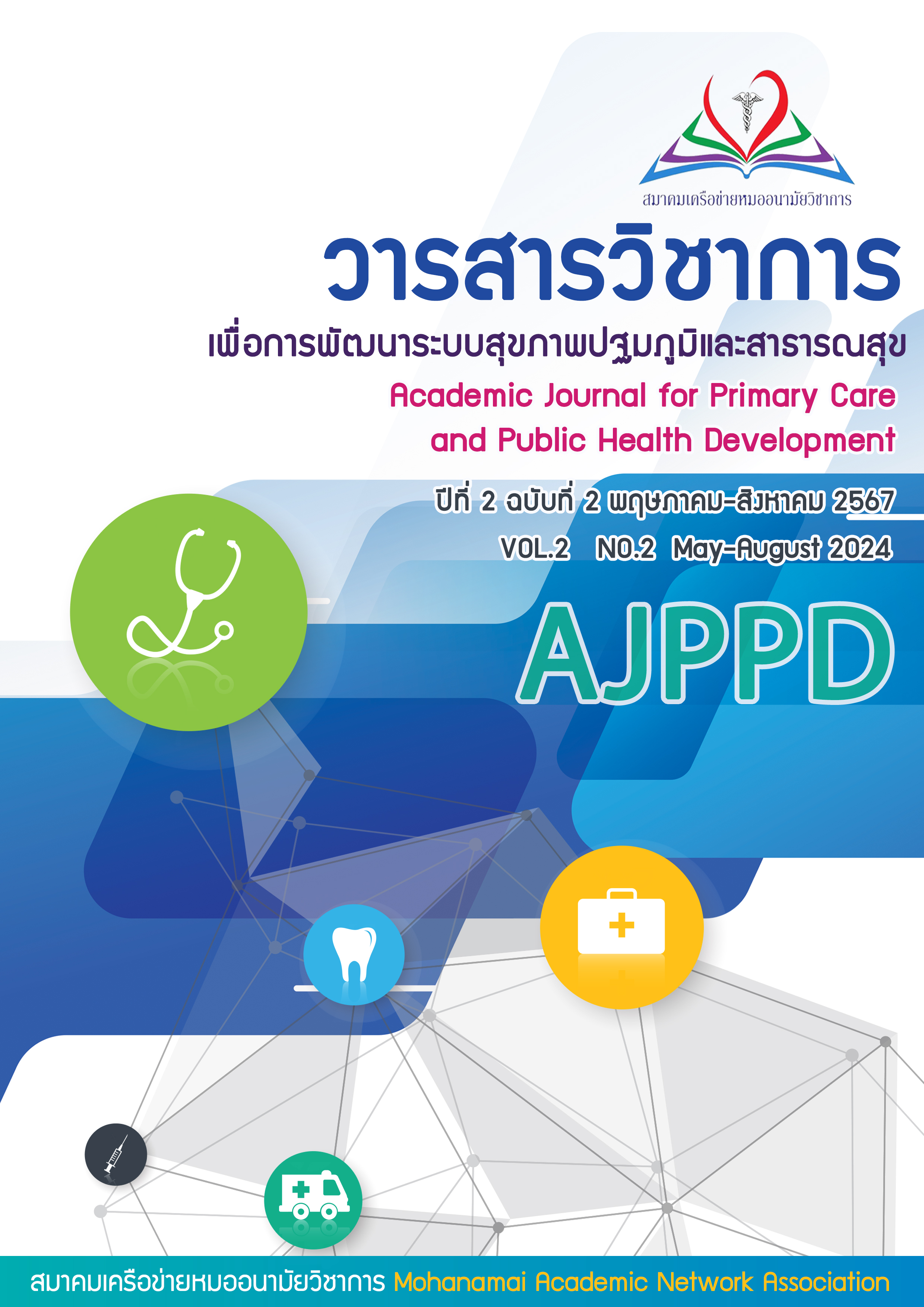The Effects of Recurrent Prevention Program for Stroke Patients Admitted to Inpatient Department, Pichai Hospital
Keywords:
Stroke, Recurrence Prevention Program, Health BehaviorAbstract
This research aimed to study the effects of a recurrence prevention program for stroke patients admitted to the inpatient department of Pichai Hospital. The study focused on assessing the risk of recurrence and comparing the perception of risk factors, the perceived benefits of preventive behaviors, and the preventive behaviors before and after participating in the program. The study employed a quasi-experimental design with a one-group pretest-posttest approach. The sample consisted of 16 first-time ischemic stroke patients aged 35 years and above, admitted to the inpatient department of Pichai Hospital. The research instruments included a recurrence prevention program, interview forms assessing risk factor perception, perceived benefits of behaviors, preventive behaviors, and a risk level assessment form. Data were analyzed using descriptive statistics and the Wilcoxon signed-rank test.
The results showed that after participating in the program, patients exhibited statistically significant increases (p < 0.05) in their perception of risk factors, perceived benefits of preventive behaviors, and preventive behaviors against recurrence. The mean score for risk factor perception increased from 10.81 to 16.88, the perceived benefits of preventive behaviors rose from 13.13 to 17.63, and preventive behaviors against recurrence increased from 37.88 to 52.63. It was concluded that the recurrence prevention program effectively enhanced stroke patients' perception of risk factors, perceived benefits of preventive behaviors, and preventive behaviors against recurrence. The findings of this research can be applied to develop care plans and educational programs for stroke patients in other healthcare facilities to reduce the risk of disease recurrence.
References
กานต์ธิชา กาแพงแก้ว. (2558). ความสัมพันธ์ระหว่างการรับรู้ปัจจัยเสี่ยง การรับรู้อาการเตือนและพฤติกรรมการดูแลตนเองเพื่อป้องกันโรคหลอดเลือดสมองในผู้สูงอายุกลุ่มเสี่ยง. วิทยานิพนธ์ปริญญา พยาบาลศาสตรมหาบัณฑิต, บัณฑิตวิทยาลัย มหาวิทยาลัยมหิดล.
จิราวรรณ วิริยะกิจไพบูลย์. (2557). ปัจจัยที่สัมพันธ์กับความร่วมมือในการป้องกันการกลับเป็นซ้ำของโรคหลอดเลือดสมองของผู้ป่วยที่รอดชีวิตจากโรคหลอดเลือดสมอง. วิทยานิพนธ์ปริญญาพยาบาลศาสตรมหาบัณฑิต, บัณฑิตวิทยาลัย จุฬาลงกรณ์มหาวิทยาลัย.
สถาบันประสาทวิทยา กรมการแพทย์ กระทรวงสาธารณสุข. (2557). คู่มือโรคหลอดเลือดสมอง (อัมพาต อัมพฤษ์) สำหรับประชาชน. พิมพ์ครั้งที่ 6.
สถาบันประสาทวิทยา กรมการแพทย์ กระทรวงสาธารณสุข. (2557). แนวทางเวชปฏิบัติภาวะสมองเสื่อม.กรุงเทพฯ: ธนาเพรส.
สุวิตรา สร้างนา (2557) ประสิทธิผลของโปรแกรมสุขศึกษาโดยประยุกต์ใช้แบบแผนความเชื่อด้านสุขภาพร่วมกับการเสริมสร้างพลังอำนาจในการปรับเปลี่ยนพฤติกรรมสุขภาพเพื่อป้องกันโรคหลอดเลือดสมองของผู้ป่วยโรคความดันโลหิตสูงในอำเภอเมือง จังหวัดชัยภูมิ. วิทยานิพนธ์ปริญญา สาธารณสุขศาสตรมหาบัณฑิต, บัณฑิตวิทยาลัย มหาวิทยาลัยขอนแก่น.
สำนักโรคไม่ติดต่อ กรมควบคุมโรค. (2558).ประเด็นสารวันรณรงค์อัมพาตโลกปี พ.ศ. 2558 (ปีงบประมาณ 2559). ค้นเมื่อ 5 มิถุนายน 2559, จาก http://www.thaincd.com/document/file/info/noncommunicable-disease/Stroke58.pdf.
หัสยาพร มะโน. (2552). การรับรู้อาการเตือนโรคหลอดเลือดสมองในผู้ป่วยโรคความดันโลหิตสูง โรงพยาบาลลอง จังหวัดแพร่. วิทยานิพนธ์ปริญญาสาธารณสุขศาสตรมหาบัณฑิต, บัณฑิตวิทยาลัย มหาวิทยาลัยเชียงใหม่
Abraham, C. & Sheeran, P. (2015). The Health belief Model. Retrieved on: 24 September2023, from https://www.researchgate.net/publication/290193215_The_Health_Belief_Model
Becker, M.H., Maiman, L.A., Kirscht, J.P., Haefner, D.P., & Drachman, R.H. (198). The Health Belief Model and prediction of dietary compliance: a field experiment. Journal of Health and Social Behavior, 348-366.
Best, J. W. (1981). Research in education. New jersey: Prentice-Hall.Centers for Disease Control and Prevention (CDC). (2012). Prevalence of stroke: United States, 2006–2010. MMWR Morb Mortal Wkly Rep, 61:379–82.
Chayawatto C. (2016). Depression in the caregivers of stroke patients.Region 4-5 Medical Journal, 35:14-27. (in Thai)
Cohen, J. (1988). Statistical power analysis for the behavioral sciences. (2nd ed.). USA: Lawrence Erlbaum associates.
Ministry of public health. (2020). Division of strategy and planning, Office of the permanent Secretary, Reported public health status of Thailand 2020. Bangkok: the printing office to assist veterans organization.
Ministry of public health. (2018). Division of non-communicable diseases, Department of Disease Control. Reported number and rate of inpatients with stroke. Bangkok: the printing office to assist veterans organization; Available from: http://www.thaincd.com/2016/mission/documents-detail.php?id=13684&tid=32&gid=1-020
Naylor M, Shaid EC, Carpenter D, Gass B, Levine C, Li J, et al. (2017). Components of comprehensive and effective transitional Care. J Am GeriatrSoc [internet]. [cited 2021/11/9].65;1119-1125. Available from: https://www.researchgate.net/publication/315776473
Yubolchit N, Praekhao C, Tiamkao S. (2019). Quality of life of acute ischemia stroke patients in middle secondary hospital in health region 7. North-Eastern Thai Journal of Neuroscience, 14: 15-36. (in Thai)
Sullivan, K. A., White, K. M., Young, R. M., Chang, A., Roos, C., & Scott, C. (2008). Predictors of Intention to Reduce Stroke Risk Among People at Risk of Stroke: An Application of an Extended Health Belief Model. Rehabilitation Psychology, 53(4), 505-51

Downloads
Published
How to Cite
Issue
Section
License

This work is licensed under a Creative Commons Attribution-NonCommercial-NoDerivatives 4.0 International License.




